Physical Address
304 North Cardinal St.
Dorchester Center, MA 02124
Squamous cell carcinoma, the most common form of oral cancer, is the sixth most frequent cancer encountered in the United States ( Fig. 62.1 ). Nearly 34,000 Americans are diagnosed with oral cavity squamous cell cancer each year, and if the oropharynx is included, that number increases by another 16,000 cases. More than 370,000 people are diagnosed worldwide. Approximately 10,000 deaths result from oral cavity squamous cell carcinoma in the United States in any one year.
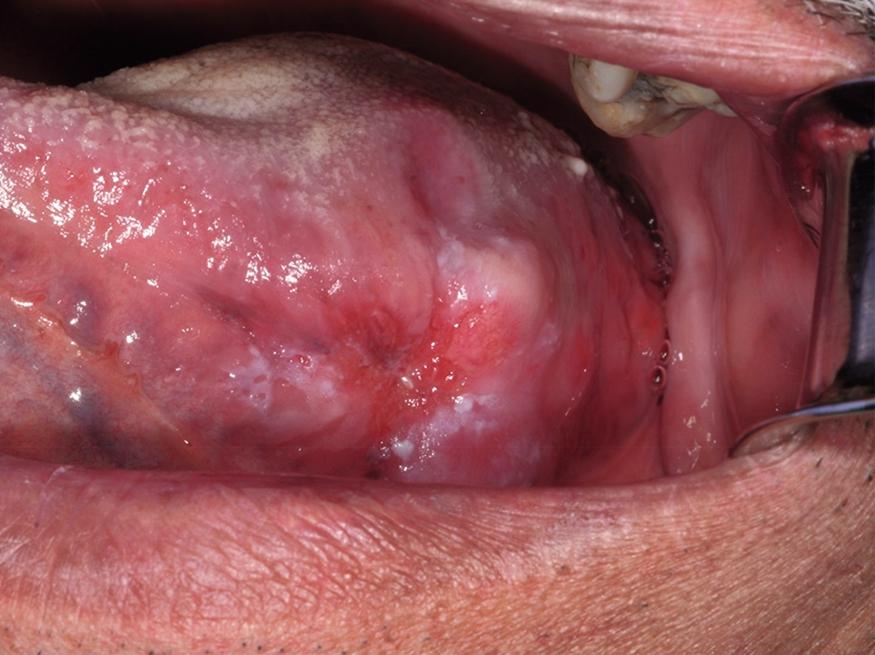
Siegel, RL, Miller KD, Jemal AJ. Cancer Statistics, 2018. CA Cancer J Clin . 2018;68:7–30.
The most significant risk factors associated with the development of oral squamous cell carcinoma are tobacco and alcohol use, sun exposure, and infection with human papillomavirus (HPV).
Kumar M, Nanavati R, Modi TG, Dobariya C. Oral cancer: etiology and risk factors: A review. J Cancer Res Ther . 2016;12:458–463.
Infection with HPV, a double-stranded epitheliotropic DNA virus with an affinity for skin and mucosa, is a leading reported cause of oral cavity and oropharyngeal cancer. More than 200 numbered strains of HPV exist, 12 of which are considered to be high-risk variants. The most common strain associated with oropharyngeal cancer is HPV-16.
Cubie H. Diseases associated with human papillomavirus infection. Virology . 2013;445:21–34.
Oral proliferative verrucous leukoplakia (PVL), a form of oral leukoplakia originally described by Hansen in 1985, is characterized by the development of multifocal, progressive, recurrent irregular white patches, plaques, or papillary growths that involve the oral mucosa. The lesions of PVL are indeed true leukoplakias and thus will not scrape off when rubbed vigorously ( Fig. 62.2 ). When viewed microscopically, PVL can display a host of histologic patterns, ranging from simple hyperkeratosis to dysplasia, verrucous hyperplasia, squamous cell carcinoma, and verrucous carcinoma.
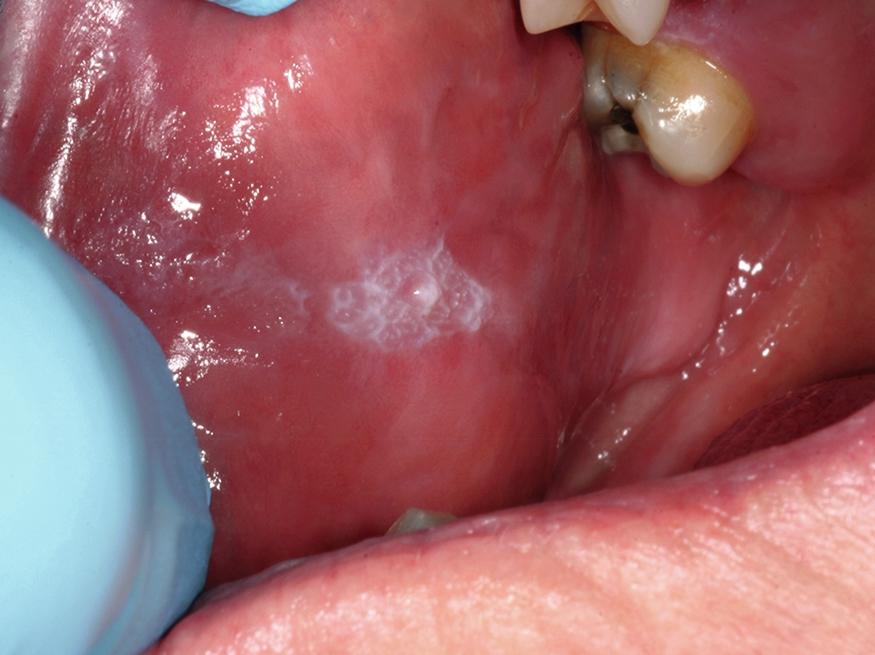
High-risk HPVs, most often HPV-16, have been identified in PVL tissue samples, suggesting that HPV plays a role in lesional development. However, the influence of an infectious agent on the pathogenesis of PVL has not been proven. PVL is far more common in women than men, and the disorder has a peak incidence in individuals between the ages 60 and 70. PVL patients may be smokers or nonsmokers. It has been reported that as high as 90% of patients with PVL will have lesions that harbor Candida albicans species. There is some evidence to suggest a possible correlation between DNA aneuploidy, expression of mcm (mini chromosomal protein maintenance) protein, or loss of heterozygosity at locus 9p21 in PVL.
Upadhyaya JD, Fitzpatrick SG, Mohammed MN, et al. A retrospective 20-year analysis of proliferative verrucous leukoplakia and it’s progression to malignancy and association with high-risk human papillomavirus. Head Neck Pathol. 2018;11:1–11.
PVL is most appropriately managed by surgical excision and close long-term patient follow-up, although laser ablation and photodynamic therapy have also been employed. Chemopreventive protocols using antifungal agents and high-dose vitamin A have been used in the treatment of PVL, but no long-term prospective longitudinal, well-controlled clinical trials using these agents have been completed.
Chen, HM, Yu CH, Tu PC, Yeh CY, Tsai T, Chiang CP. Successful treatment of oral verrucous hyperplasia and oral leukoplakia with topical 5-aminolevulinic acid-mediated photodynamic therapy. Lasers Surg Med . 2005;37:114–122.
RAU of the oral cavity is a painful ulcerative disorder characterized by the development of round to ovoid ulcers of the oral mucosa. Lesional ulcers are typically surrounded by an inflammatory halo ( Fig. 62.3 ). Aphthous ulcers can be divided into major, minor, and herpetiform subtypes. Major ulcers are typically 1 cm or more in diameter, whereas minor ulcers typically measure 2 to 8 mm in diameter. Herpetiform ulcers tend to occur in clusters or bunches of small pinpoint ulcers that develop and then coalesce. Most aphthous ulcers will develop on freely movable nonkeratinized oral mucosa. The most common RAU sites are the buccal mucosa, vestibular mucosa, lip mucosa, ventral surface of the tongue, and the soft palatal mucosa. The prevalence of recurrent aphthous ulcers in the oral cavity is thought to be approximately 1 per 100 persons and the disorder is more common in adults than children.
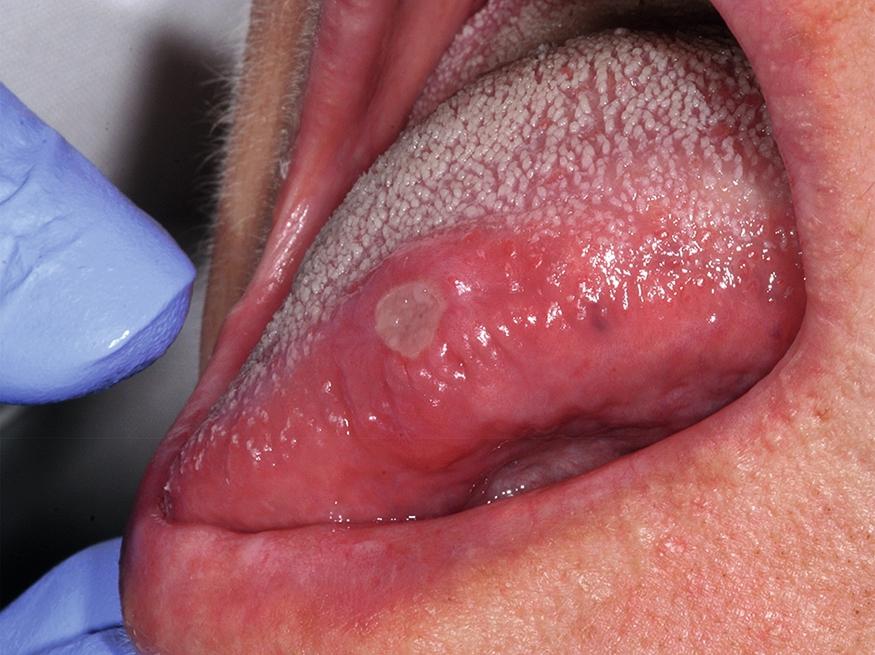
Table 62.1 describes the most commonly used topical and systemically employed agents for treating recurrent aphthous stomatitis, and the possible use-associated side effects.
| Topical agents | Dosage, efficacy, and possible side effects |
|---|---|
| Corticosteroids | High-strength formulations preferred |
| Amlexanox | Typically employed for minor RAUs |
| Antibiotics | Employed as a rinse for patients with multiple ulcers |
| Chlorhexidine gluconate | Questionable effectiveness |
| Systemic Agents | |
| Thalidomide | Reserved for rare refractory cases |
| Dapsone | Immunosuppressive |
| Pentoxifylline | Efficacy has not been determined |
| Colchicine | Extreme gastrointestinal toxicity may be seen |
Akintoge SO, Greenberg MS. Recurrent aphthous stomatitis. Dent Clin North Am. 2014;58:281–297.
Belenguer-Guallar I, Jimenez-Soriano Y, Claramunt-Lozano A. Treatment of recurrent aphthous stomatitis: a literature review. J Clin Exp Dent. 2014;6:e168–e174.
Oral lichen planus (OLP), which typically affects the oral cavity as striated white mucosal lesions, accounts for approximately 9% of all white lesions that affect the oral mucous membranes ( Fig. 62.4 ). While OLP affects people of all ethnic groups, women are more commonly affected than men, and most patients will develop the disease between 30 and 60 years of age. The disorder is not limited to the oral cavity and can affect skin, scalp, and nails. OLP is a chronic disease, the etiology of which is not completely understood. Some investigators believe that an immune reaction mediated by a virus such as hepatitis C may be causal, resulting in epithelial basal layer cells being damaged, ultimately resulting in an oral vesicular bullous eruption. Other investigators suggest that psychological disorders, such as stress, allergies, injury, or infection, may be causal factors. Most authorities agree, however, that the disease is a CD8 + T cell–mediated autoimmune disorder.
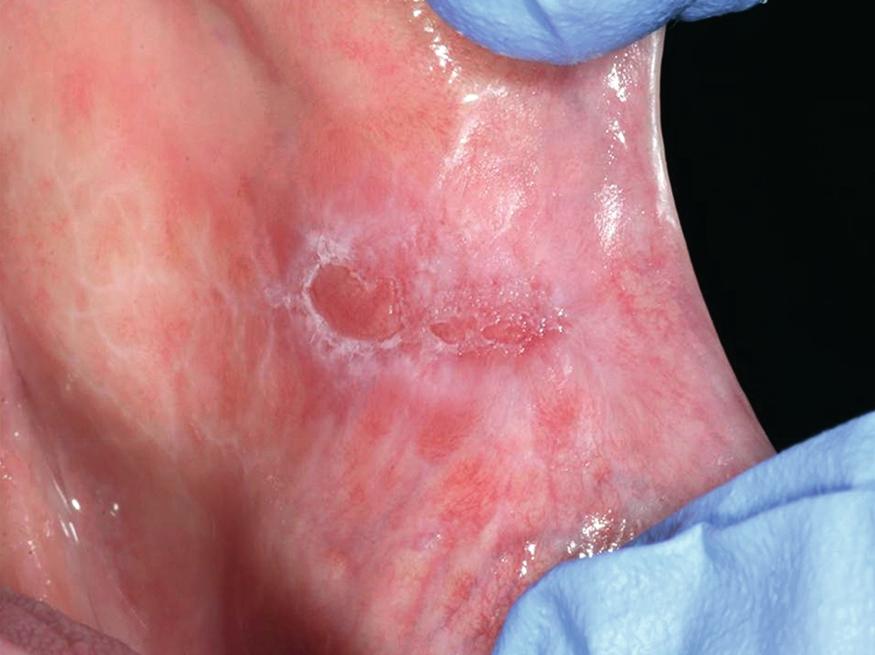
The World Health Organization (WHO) diagnostic criteria for the diagnosis of OLP are listed in Table 62.2 .
| Clinical criteria | The identification of white papular, reticular, annular, plaque-type lesions that may show gray-white lines radiating from papules. |
| Identification of a lacelike network of slightly raised gray-white lines arranged in a reticular pattern. | |
| The presence of atrophic lesions with or without erosion, and possibly bullae development. | |
| Histopathologic criteria | Identification of thickened ortho- or parakeratinized lesional tissue in sites that are normally keratinized. If the lesional site is normally nonkeratinized, this keratin layer may be quite thin. |
| Identification of Civatte or colloid bodies in basal layer epithelium, and the superficial connective tissue. | |
| Identification of a well-defined bandlike zone of inflammatory cells that is confined to the superficial part of the connective tissue, and consists primarily of lymphocytes. | |
| Signs of liquefaction degeneration of the basal cell epithelial layer. |
The WHO regards OLP as a disease that may evolve to cancer. In published literature reviewed between the years 1985 and 2004, the malignant transformation rate for OLP to squamous cell carcinoma was reported to be between 0% and 5.3%. Greer and colleagues reviewed 588 cases of OLP over a 20-year period in which study patients underwent a minimum of six biopsies and routine long-term diagnostic follow-up. These studies showed a 2.01% transition rate of OLP to squamous cell carcinoma. Most patients with OLP who develop oral squamous cell carcinoma in association with the disease will present with ulcerative, erosive lesions that are often also distinctly papillary. There is a clear female predilection, and the tongue is the favored site for such lesions.
Treatment for OLP is designed to alleviate symptomatology. Medications that can be used to achieve this include topical or systemic corticosteroids, interlesional injections of steroids, tacrolimus, retinoids, and cryosurgery. Tobacco and alcohol use should be discouraged in OLP patients, and patients with high-risk ulcerative and/or papillary-appearing OLP should be screened for HPV infection and lichenoid dysplasia.
Greer RO, McDowell JD, Hoernig G. Oral lichen planus: a premalignant disease. Pathol Case Rev. 1999;4:28–34.
Skully C, Carrozzo M. Oral mucosal disease. Lichen planus. Br J Oral Maxillofac Surg. 2008;46:15–21.
Giuliani M, Troiano G, Cordaro M, et al. Rate of malignant transformation of oral lichen planus: a systemic review. Oral Dis . 2019;25:693–709. doi:10.1111/odi.12885.
Geographic tongue is a benign condition of the oral mucous membranes that occurs in approximately 1% to 3% of the population. Females are affected more often than males, and the disorder is most often characterized by the presence of well-demarcated desquamated erythematous zones involving the tongue papilla. These desquamated zones will be marginated by a white border ( Fig. 62.5 ). Lesions tend to be more concentrated along the tip and the lateral borders of the tongue than in other tongue sites. Suggested etiologies include allergies, hormonal disturbances, nutritional deficiencies, psychological factors, juvenile diabetes, and pustular psoriasis.
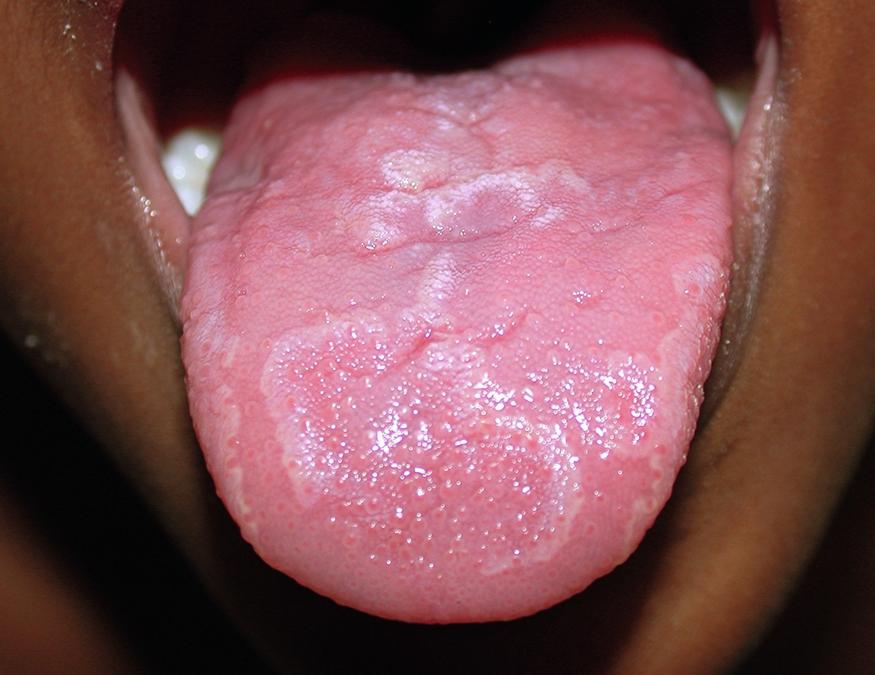
The erythema that is seen in association with geographic tongue is caused by atrophy of the tongue's filiform papilla. Lesions tend to heal or resolve quickly over a 2- to 4-week course and then move on to other sites on the tongue. Patients with geographic tongue can be symptomatic or asymptomatic, although most patients will be asymptomatic. Symptomatic patients will often complain of a burning sensation or sensitivity to hot or spicy foods, toothpaste, or tobacco.
Yes. Geographic tongue can affect other oral mucosal sites, including the buccal mucosa and labial mucosa. When this form of the disease occurs, the disorder is typically known as ectopic geographic tongue or erythema arenata migrans . Oral erythema arenata migrans has no relationship to the erythema chronicum migrans lesions that occur in Lyme disease. The etiology of geographic tongue remains unknown, although stress, infection with Candida albicans , and hypersensitivity to certain environmental factors have all been implicated in the etiology of the disorder. Typically no treatment is indicated in patients who have asymptomatic geographic tongue. Occasional application of topical corticosteroids has proven beneficial, for symptomatic patients.
Alikhani K, Khalighinejad N, Ghalaiani P, Khaleghi MA, Askari E, Gorsky M. Immunologic and psychologic parameters associated with geographic tongue. Oral Surg Oral Med Oral Pathol Oral Radiol. 2014;118:68–71.
Mucous membrane pemphigoid (MMP), classified as cicatricial pemphigoid in the dermatologic literature, is an autoimmune mucocutaneous disease that is chronic and blister forming. In this disorder, antibodies that are tissue bound become directed against one or more components of basement membrane substance. Benign MMP tends not to be associated with scarring of the mucosa, unlike the scar-prone lesions that affect skin and ocular mucosa. The vast majority of patients with MMP will be in the 50- to 60-year age range, and females are affected more frequently than males at a ratio of 2:1. In addition to eye, oral, and skin lesions, patients can also develop nasal, esophageal, laryngeal, and vaginal lesions.
Oral lesions typically present as a diffuse erythematous gingivitis that may vesiculate ( Fig. 62.6 ). In the past, the disorder has inappropriately been referred to as desquamative gingivitis , although desquamative lesions of the gingiva are clearly not diagnostic of MMP. Other clinical differential diagnoses that should be considered include lichen planus, pemphigus, erythema multiforme, and lupus erythematosus.
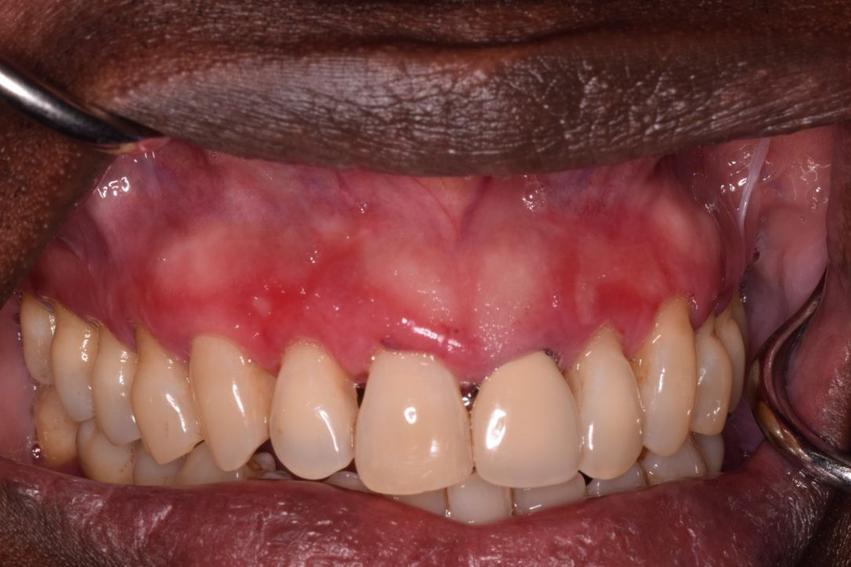
MMP can be diagnosed by routine hematoxylin and eosin (H&E)–stained evaluation of a biopsy specimen, often in concert with associated direct immunofluorescence studies. Assessment of perilesional tissue is most diagnostic. Lesional blisters, when biopsied, are typically not diagnostic. The lesions of MMP result in subepithelial clefting in which immunoreactants, when viewed with immunofluorescence, will be demonstrable along the basement membrane zone. Deposits of immunoglobulin G (IgG) and C3 are common immunoreactants at the basement membrane zone in 9 out of 10 patients. Rarely, IgA and IgM can also be identified. From a diagnostic standpoint, other disorders, including linear IgA disease, epidermolysis bullosa acquisita, and hemorrhagic bullae, can be confused with benign MMP, both clinically and microscopically. Therefore, a thorough and appropriate clinical and laboratory workup of the patient suspected of having MMP is mandatory.
Become a Clinical Tree membership for Full access and enjoy Unlimited articles
If you are a member. Log in here